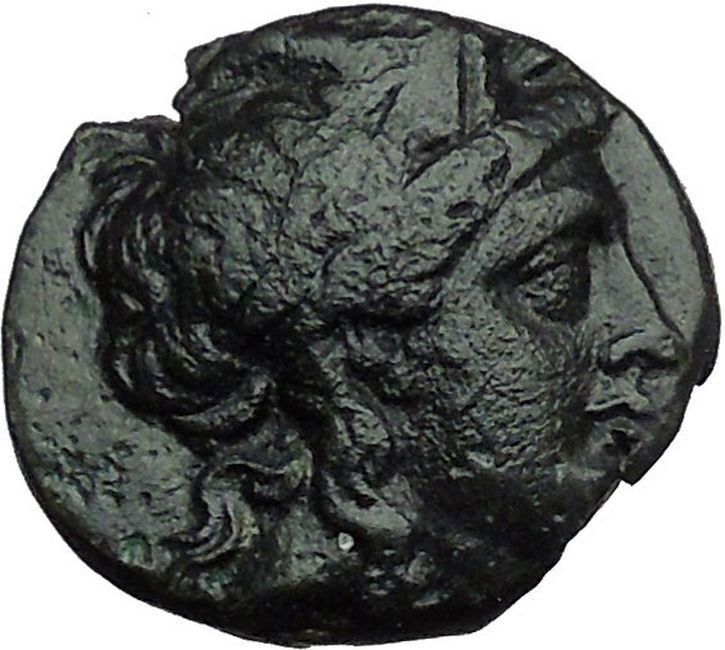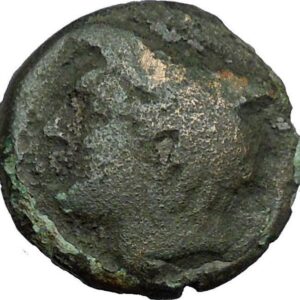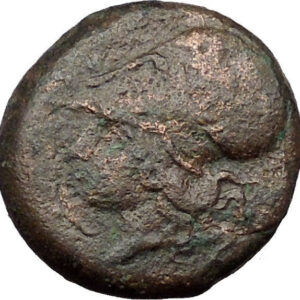|
Greek city of
Katane in
Sicily
Bronze 18mm (4.93 grams) Struck late second-first centuries B.C.
Reference: HGC 2, 625 (Rare R1);
CNS III, p. 97-97, nos. 8-9/5; SNG ANS 1273
Young river-god Amenanos reclining right on overturned amphora, holding
cornucopia and reed.
KATANAIΩN, The caps of the Dioscuri, pilei, surmounted by stars; own on
monogram between.
Following the capture by Hieron of Syracuse, in 476 B.C., the
name of this city was changed to Aitna; but on the expulsion of the the new
colonists, fifteen years later, the place reverted to its original name of
Katane. It was captured in 404 B.C. by Dionysios of Syracuse who sold the
population into slavery. Katane submitted to Rome during the First Punic War.
You are bidding on the exact
item pictured, provided with a Certificate of Authenticity and Lifetime
Guarantee of Authenticity.
River-gods were represented often on Greek, Greek Imperial
(Roman Provincial) and Roman Imperial coins, as a personification of a river
that flowed through that area, as it was an important feature of a city. The
coins of the Roman Republic do not have any representations of river gods. Some
river gods represented on ancient coins were that of the Tiber, Nile, Danube and
many more. River gods on ancient Roman coins are most often depicted on Roman
provincial issues (another term for Greek Imperial). There are also Greek coins
that depicted personifications of river-gods usually as the head of that god. On
Greek Imperial coins, the river-god is usually depicted reclining, holding
reeds, and leaning on over-turned jug from which water flows.

Gemini
is one of the
constellations
of the
zodiac
. It was one of the 48 constellations
described by the 2nd century AD astronomer
Ptolemy
and it remains one of the 88 modern
constellations today. Its name is
Latin
for "twins,"
and it is associated with the twins
Castor and Pollux
in
Greek mythology
. Its symbol is

(Unicode ♊).
In
Greek
and
Roman mythology
,
Pollux and Castor or Polydeuces were twin brothers, together known as the
Dioskouri. Their mother was
Leda
, but Castor was the mortal son of
Tyndareus
, the king of Sparta, and Pollux the
divine son of Zeus
, who seduced Leda in the guise of a swan.
Though accounts of their birth are varied, they are sometimes said to have been
born from an egg, along with their twin sisters
Helen of Troy
and
Clytemnestra
.
In Latin the twins are also known as the Gemini or Castores.
When Castor was killed, Pollux asked Zeus to let him share his own immortality
with his twin to keep them together, and they were transformed into the
constellation
Gemini
. The pair were regarded as the patrons
of sailors, to whom they appeared as
St. Elmo’s fire
, and were also associated with
horsemanship.
They are sometimes called the Tyndaridae or Tyndarids, later
seen as a reference to their father and stepfather
Tyndareus
.

The
pileus (Greek
πῖλος – pilos, also pilleus or pilleum in
Latin
) was a brimless,
felt cap worn in
Ancient Greece
and surrounding regions, later
also introduced in
Ancient Rome
. The Greek πιλίδιον (pilidion)
and Latin pilleolus were smaller versions, similar to a skullcap.
The pileus was especially associated with the
manumission
of
slaves
. who wore it upon their liberation. It
became emblematic of
liberty
and freedom from bondage. During the
classic revival of the 18th and 19th centuries it was widely confused with the
Phrygian cap
which, in turn, appeared
frequently on
statuary
and
heraldic
devices as a "liberty cap."
Greece
The pilos (Greek: πῖλος, felt) was a common conical
travelling hat in
Ancient Greece
. The pilos is the brimless
version of the
petasos
. It could be made of felt or
leather. Their pilos cap identifies the
Dioscuri, Castor and Pollux
, in sculptures,
bas-reliefs and vase-paintings; their caps were already explained in Antiquity
as the remnants of the egg from which they hatched. The pilos appears on
votive figurines
of boys at the sanctuary of
the
kabeiri
at
Thebes
, the Kabeirion.
In warfare, the pilos type helmet was often worn by the
peltast
light infantry, in conjunction with the
exomis
, but it was also worn by the heavy
infantry.
The pilos helmet was made of bronze in the same shape as the pilos
which was presumably sometimes worn under the helmet for comfort, giving rise to
the helmet’s conical shape. The first widespread adoption of the pilos helmet
occurred in Sparta towards the end of the 5th century BC.
Rome

In
Ancient Rome, a slave was freed in a ceremony in which a
praetor
vindicta and pronounced him to be free. The slave’s head was shaved and a
pileus was placed upon it. Both the vindicta and the cap were considered
symbols of Libertas
, the goddess representing liberty..
manumissio minus justa)
considered less legally sound than manumission in a court of law.
One 19th century dictionary of classical antiquity states:
- Among the Romans the cap of felt was the emblem of liberty. When a slave
obtained his freedom he had his head shaved, and wore instead of his hair an
undyed pileus (πίλεον λευκόν,
Diodorus Siculus
Exc. Leg. 22 p. 625, ed.
Wess.; Plaut.
Amphit. I.1.306;
Persius
, V.82). Hence the phrase servos
ad pileum vocare is a summons to liberty, by which slaves were
frequently called upon to take up arms with a promise of liberty (Liv.
XXIV.32). The figure of Liberty on some of the coins of
Antoninus Pius
(1).jpg/330px-Mochuelo_Común_(_Athene_noctua_)(1).jpg)
In
Greek mythology
, a
Little Owl
Athene noctua)
traditionally represents or accompanies
Athena
, the virgin goddess of wisdom, or
Minerva
, her
syncretic
incarnation in
Roman mythology
. Because of such association,
the bird — often referred to as the "owl
of Athena" or the "owl of Minerva" — has been used as a symbol of
knowledge, wisdom, perspicacity and erudition throughout the
Western world
.
Some authors believe that, in early times, Athena was either an
owl
herself or a
bird goddess
in general: In the third Book of
the Odyssey
, she takes the form of a
sea-eagle
. These authors argue that she dropped
her prophylactic owl-mask before she lost her wings. “Athena, by the time she
appears in art,” Jane Ellen Harrison had remarked, “has completely shed her
animal form, has reduced the shapes she once wore of snake and bird to
attributes, but occasionally in
black-figure vase-paintings
she still appears
with wings.
The
modern West
generally associates owls with
wisdom
. This link goes back at least as far as
Ancient Greece
, where
Athens
, noted for art and scholarship, and
Athena
, Athens’ patron goddess and the goddess
of wisdom, had
the owl
as a symbol.
Marija Gimbutas
traces veneration of the owl as
a goddess, among other birds, to the culture of
Old Europe
, long pre-dating
Indo-European
cultures.
Owls, birds
of the
order
Strigiformes, include about 200
species
of mostly
solitary
and
nocturnal
birds of prey
typified by an upright stance, a
large, broad head, binocular vision and binaural hearing, and feathers adapted
for silent flight. Exceptions include the diurnal
northern hawk-owl
and the gregarious
burrowing owl
. Owls hunt mostly small
mammals
,
insects
, and other birds, although a few
species specialize in hunting
fish. They are found in all regions of the Earth except
Antarctica
and some remote islands. Owls are
divided into two
families
: the
true owls
, Strigidae; and the
barn-owls
, Tytonidae.
Katane in Sicily
Foundationnn
All ancient authors agree in representing Catania as a
Greek colonyy
named
Κατάνη (‘Katánē—see also
List of traditional Greek place names
) of
Chalcidic
origin, but founded immediately from
the neighboring city of
The port of Catania also, which was in great part filled up by the eruption
of
1669 AD
, appears to have been in ancient times
much frequented, and was the chief place of export for the corn of the rich
neighboring plains. The little river Amenanus, or Amenas, which flowed through
the city, was a very small stream, and could never have been navigable.
Catania was in consequence exempted, for 10 years, from its usual
contributions to the Roman state The greater part of the broad tract of plain to
the southwest of Catania (now called the Piana di Catania, a district of
great fertility), appears to have belonged, in
ancient times
, to Leontini or Centuripa (modern
Centuripe
), but that portion of it between
Catana itself and the mouth of the Symaethus, was annexed to the territory of
the latter city, and must have furnished abundant supplies of grain.
One of the most serious
eruptions
of
Mount Etna
happened in
121 BC
, when great part of Catania was
overwhelmed by streams of lava, and the hot ashes fell in such quantities in the
city itself, as to break in the roofs of the houses.
It retained its colonial rank, as well as its prosperity, throughout the
period of the
Roman Empire
; so that in the 4th century
Ausonius
in his
Ordo Nobilium Urbium
, notices Catania and
Syracuse alone among the cities of Sicily.
It subsequently suffered severely from the ravages of
Sextus Pompeius
, and was in consequence one of
the cities to which a
colony
was sent by
Augustus
; a measure that appears to have in a
great degree restored its prosperity, so that in
Strabo
‘s time it was one of the few cities in
the island that was in a flourishing condition.
Cicero
repeatedly mentions it as, in his time,
a wealthy and flourishing city; it retained its ancient municipal institutions,
its
chief magistrate
bearing the title of
Proagorus; and appears to have been one of the principal ports of Sicily for
the export of corn.
It appears to have continued afterwards steadily to maintain its friendly
relations with Rome, and though it did not enjoy the advantages of a confederate
city (foederata civitas), like its neighbors Tauromenium (modern
Taormina
) and Messana (modern
Messina
), it rose to a position of great
prosperity under the Roman rule.
In the
First Punic War
, Catania was one of the first
among the cities of Sicily, which made their submission to the
Roman Republic
, after the first successes of
their arms in 263 BC. The expression of
Pliny
(vii. 60) who represents it as having
been taken by
Valerius Messalla
, is certainly a mistake.
Roman
rule
The occurrence is referred by
Hyginus
to the first eruption of Etna that took
place after the settlement of Catania.
In ancient times Catania was associated with the legend of
Amphinomus and Anapias
, who, on occasion of a
great eruption of Etna, abandoned all their property, and carried off their aged
parents on their shoulders, the stream of lava itself was said to have parted,
and flowed aside so as not to harm them. Statues were erected to their honor,
and the place of their burial was known as the Campus Piorum; the
Catanaeans even introduced the figures of the youths on their coins, and the
legend became a favorite subject of allusion and declamation among the
Latin poets
, of whom the younger
Lucilius
and
Claudian
have dwelt upon it at considerable
length.
The first introduction of dancing to accompany the flute, was also ascribed
to
Andron
, a citizen of Catania
Xenophanes
, the philosopher of
Elea
, also spent the latter years of his life
there, so that it was evidently, at an early period, a place of cultivation and
refinement.
Catania was the birth-place of the philosopher and legislator Charondas; it
was also the place of residence of the poet
Stesichorus
, who died there, and was buried in
a magnificent sepulchre outside one of the gates, which derived from thence the
name of Porta Stesichoreia. (Suda,
under Στησίχορος.)
Catania was now restored to liberty, and appears to have continued to retain
its independence; during the wars of
Agathocles
with the Carthaginians, it sided at
one time with the former, at others with the latter; and when
Pyrrhus
landed in Sicily, Catania was the first
to open its gates to him, and received him with the greatest magnificence.
Callippus
, the assassin of Dion of Syracuse,
when he was expelled from Syracuse, for a time held possession of Catania (Plut.
Dion. 58); and when
Timoleon
landed in Sicily Catania was subject
to a despot named
Mamercus
, who at first joined the
Corinthian
leader but afterwards abandoned his
alliance for that of the Carthaginians, and was in consequence attacked and
expelled by Timoleon.
These, however, quit it again in
396 BC
, and retired to
Aetna
, on the approach of the great
Carthaginian
armament under
Himilco
and
Mago
. The great sea-fight in which the latter
defeated
Leptines
, the brother of Dionysius, was fought
immediately off Catania, and the city apparently[ wordsweasel]
fell, in consequence, into the hands of the Carthaginians.
There is no information as to the fate of Catania after the close of this
expedition: it is next mentioned in
403 BC
, when it fell into the power of
Dionysius I of Syracuse
, who sold the
inhabitants as slaves, and gave up the city to plunder; after which he
established there a body of
Campanian
mercenaries.
On that occasion the Catanaeans, notwithstanding their Chalcidic connections,
at first refused to receive the Athenians into their city: but the latter having
effected an entrance, they found themselves compelled to espouse the alliance of
the invaders, and Catania became in consequence the headquarters of the Athenian
armament throughout the first year of the expedition, and the base of their
subsequent operations against Syracuse.
The period that followed the settlement of affairs at this epoch appears to
have been one of great prosperity for Catania, as well as for the Sicilian
cities in general: however, no details of its history are known till the great
Athenian
expedition to Sicily
(part of the larger
Peloponnesian War
).
But this state of things was of brief duration, and a few years after the
death of Hieron and the expulsion of
Thrasybulus
, the Syracusans combined with
Ducetius
, king of the
Siculi
, to expel the newly settled inhabitants
of Catania, who were compelled to retire to the fortress of
Inessa
(to which they gave the name of Aetna),
while the old Chalcidic citizens were reinstated in the possession of Catania,
461 BC
.
He at the same time changed the city’s name to
Αἴτνη (Aítnē, Aetna or Ætna,
after the nearby
Mount Etna
, an active
volcano
), and caused himself to be proclaimed
the
Oekist
or founder of the new city. As such he
was celebrated by Pindar
, and after his death obtained heroic
honors from the citizens of his new colony.
It seems to have retained its independence till the time of
Hieron of Syracuse
, but that despot, in
476 BC
, expelled all the original inhabitants,
whom he established at Leontini, while he repeopled the city with a new body of
colonists, amounting, it is said, to not less than 10,000 in number, and
consisting partly of
Syracusans
, partly of
Peloponnesians
.
But from the fact that his legislation was extended to the other Chalcidic
cities, not only of Sicily, but of
Magna Graecia
also, as well as to his own
country, it is evident that Catania continued in intimate relations with these
kindred cities.
The only event of its early history that has been transmitted to us is the
legislation of
Charondas
, and even of this the date is wholly
uncertain.
Greek
Sicily
The exact date of its foundation is not recorded, but it appears from
Thucydides
to have followed shortly after that
of Leontini (modern
Lentini
), which he places in the fifth year
after
Syracuse
, or
730 BC
.
Naxos
|







(1).jpg/330px-Mochuelo_Común_(_Athene_noctua_)(1).jpg)




